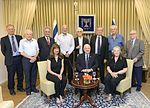Museum for Islamic Art, Jerusalem
1974 establishments in IsraelArt museums and galleries in IsraelArt museums established in 1974Decorative arts museumsIslam in Jerusalem ... and 3 more
Islamic museumsKatamonMuseums in Jerusalem

The Museum for Islamic Art (formerly known as the L.A. Mayer Institute for Islamic Art) (Hebrew: מוזיאון ל. א. מאיר לאמנות האסלאם; Arabic: معهد ل. أ. مئير للفن الإسلامي) is a museum in Jerusalem, established in 1974. Located on the corner of HaPalmach Street in Katamon, down the road from the Jerusalem Theater, it houses Islamic pottery, textiles, jewelry, ceremonial objects and other Islamic cultural artifacts.
Excerpt from the Wikipedia article Museum for Islamic Art, Jerusalem (License: CC BY-SA 3.0, Authors, Images).Museum for Islamic Art, Jerusalem
HaPalmach, Jerusalem Old Katamon
Geographical coordinates (GPS) Address Website External links Nearby Places Show on map
Geographical coordinates (GPS)
| Latitude | Longitude |
|---|---|
| N 31.768727777778 ° | E 35.212836111111 ° |
Address
מוזיאון לאומנות האיסלאם
HaPalmach
9218812 Jerusalem, Old Katamon
Jerusalem District, Israel
Open on Google Maps











